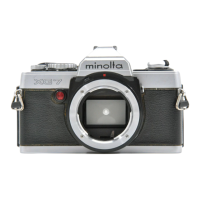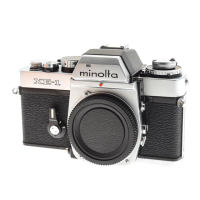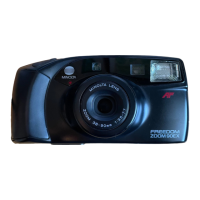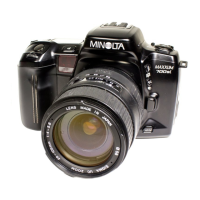latch controls the position of the power-
winder switch. To check the adjustment,
again partially cock the shutter. With the
transport latch against the outer edge of
the transport cam, the gold spring should
come against the edge of the power-
winder bushing. Fig. 128. Turn the brass
eccentric so that it just touches the gold
wire.
Now complete the cocking stroke and
allow the wind lever to return slowly.
When the transport latch drops into
engagement with the first step in the
transport cam, check the position of the
gold wire — the gold wire should com
pletely clear the hole in the power-winder
bushing. ■
CONCLUSIONS ON THE XD-11
Some technicians have complained
that the modern generation of electronic
SLRs can't provide the ruggedness and
versatility needed by professional
photographers. Not so the with XD-11.
The XD-11 can withstand just about any
punishment a pro can dish out. Plus it of
fers the versatility of every possible opera
tional mode.
As one example of the durability, we
recently received an XD-11 which had
taken a spill off a motorcycle traveling
80mph. The impact made a mess of the
top cover and the rewind knob. Yet the
camera still worked!
The versatility comes from the choice
between manual operation, automatic
shutter speeds, or automatic diaphragm
openings. There's also a third mode, one
not publicized — fully programmed
operation. In the S mode, the XD-11 sets
the diaphragm opening and, if necessary,
changes the shutter speed automatically.
You can then leave the speed knob at the
1/125 setting in the S mode. The XD-11
uses the 1/125 shutter speed if it can.
But, if 1/125 won't produce the proper
exposure, the XD-11 selects the shutter
speed it needs.
Another of the XD-11 's strong points is
the shutter. More and more cameras are
going to the compact Seiko — the Pentax
ME and MV, the Nikon EM, and the
Mamiya ZE to name a few. The repair
techniques we've described for the XD-11
shutter also apply to the Seikos used in
other cameras.
The Seiko makes the camera excep
tionally modular as well as durable. Those
white, plastic gears in the Seiko aren't
nylon — they're Delrin, the toughest of
plastics. The Delrin parts never seem to
break. Although the Seiko holds up under
most types of abuse, there's one mis
treatment it can't take — water damage.
Water quickly destroys the metal blades.
We've tried to cover the trouble
shooting and repair techniques through
out this article. The following chart pro
vides a summary of the troubleshooting:
Summary of troubleshooting:
Symptom
Blades stick
Shutter will not
release, LEDs o.k.
Shutter hangs
open on all
electronic
Cause
1. Oil on blades
1. Release magnet M1, Fig. 60, sticking
(grease between magnet core and
armature).
2. Release switch S3, Fig. 101 — poor
contact or out of adjustment.
3. Reset switch S1, Fig. 128 — poor
contact. S1 should be closed with
the shutter cocked.
4. Ground screw on lower circuit board
loose.
5. Release magnet M1, capacitor C6, or
transistor T6 on lower circuit board.
Test by shorting the yellow wire on
the lower circuit board to ground;
the shutter should release, Fig. 22.
6. IC2. Check the voltage at the yellow
wire on the lower circuit board; the
voltage should drop from 3V to OV
when you close S3, shutter cocked.
The LED base plate, Fig. 104, is not
available separately; replace the
complete flex.
1. Insulator off lever that opens
memory switch, Fig. 33.
Symptom
Camera jams with
lens installed
(diaphragm fails
to reopen)
Film will not
advance
Overexposure at
high light levels
and fast manual
speeds
No LEDs with
release button
button partially
depressed,
shutter works ok
Cause
ground. Check with an ohmmeter
between ground and the black wire,
Fig. 39; you should measure direct
continuity with the shutter cocked,
no continuity with the shutter
released.
3. Memory switch, Fig. 33 — poor
contact.
1. Mirror-tensioning lever, Fig. 108
— sticking.
1. Wind latch out of adjustment,
Fig. 128.
2. Take-up spool, lower section, broken
loose.
1. Oil on interface of shutter electro
magnet and armature.
1. Metering switch S5, Fig. 101 poor
contact or out of adjustment. Check
by shorting the green wire, Fig. 39,
to ground. If the LEDs then turn on,
pull the mirror cage and clean the
metering switch.
functions 2. Trigger-switch wire blade or black
wire to shutter module shorted to
2. Switch S7, Fig. 61, poor contact.
The pin on the M1 armature should

